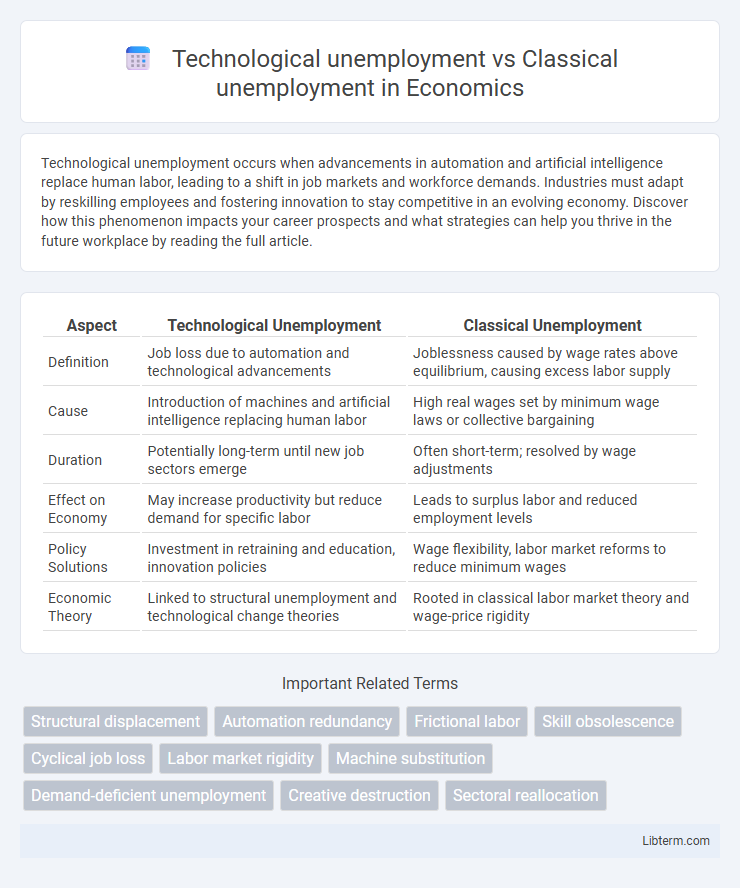Technological unemployment occurs when advancements in automation and artificial intelligence replace human labor, leading to a shift in job markets and workforce demands. Industries must adapt by reskilling employees and fostering innovation to stay competitive in an evolving economy. Discover how this phenomenon impacts your career prospects and what strategies can help you thrive in the future workplace by reading the full article.
Table of Comparison
| Aspect | Technological Unemployment | Classical Unemployment |
|---|---|---|
| Definition | Job loss due to automation and technological advancements | Joblessness caused by wage rates above equilibrium, causing excess labor supply |
| Cause | Introduction of machines and artificial intelligence replacing human labor | High real wages set by minimum wage laws or collective bargaining |
| Duration | Potentially long-term until new job sectors emerge | Often short-term; resolved by wage adjustments |
| Effect on Economy | May increase productivity but reduce demand for specific labor | Leads to surplus labor and reduced employment levels |
| Policy Solutions | Investment in retraining and education, innovation policies | Wage flexibility, labor market reforms to reduce minimum wages |
| Economic Theory | Linked to structural unemployment and technological change theories | Rooted in classical labor market theory and wage-price rigidity |
Introduction to Unemployment Types
Technological unemployment arises when automation and advanced technologies replace human labor, leading to job displacement in industries such as manufacturing and services. Classical unemployment occurs due to wage rigidity, where wages remain above the equilibrium level, causing a surplus of labor and unfilled job vacancies. Understanding these unemployment types is crucial for policymakers to tailor strategies that address both structural changes in the labor market and wage-setting mechanisms.
Defining Classical Unemployment
Classical unemployment occurs when wages are set above the market-clearing level, often due to minimum wage laws, labor unions, or efficiency wages, resulting in a surplus of labor. Unlike technological unemployment, which arises from automation and technological advancements replacing jobs, classical unemployment stems from price rigidities within the labor market. Understanding classical unemployment involves analyzing wage rigidity and its impact on labor supply and demand equilibrium.
Understanding Technological Unemployment
Technological unemployment occurs when advancements in automation and artificial intelligence replace human labor, causing job displacement predominantly in manufacturing and routine-based sectors. Classical unemployment arises from mismatches between workers' skills and job requirements or from cyclical economic downturns leading to reduced demand for labor. Understanding technological unemployment requires analyzing how innovation disrupts labor markets by shifting job structures and necessitating workforce reskilling to adapt to new technological paradigms.
Key Causes of Classical Unemployment
Classical unemployment primarily results from wage rigidity and labor market imperfections, where minimum wage laws, labor unions, and employment protection legislation prevent wages from adjusting to equilibrium levels. This leads to excess labor supply as employers reduce hiring due to higher wage costs. Unlike technological unemployment, which is driven by automation and innovation, classical unemployment stems from institutional constraints that hinder labor market flexibility.
Drivers Behind Technological Unemployment
Technological unemployment is driven primarily by automation, artificial intelligence, and machine learning replacing human labor in various industries, leading to a structural shift in job availability. In contrast, classical unemployment results from cyclical economic downturns, mismatches in labor supply and demand, or frictional factors like job transitions. The rapid advancement of digital technologies and robotics accelerates displacement in manufacturing, services, and routine cognitive tasks, distinguishing technological unemployment's root causes from the traditional macroeconomic influences on classical unemployment.
Economic Impacts of Classical vs Technological Unemployment
Classical unemployment arises from wage rigidities and labor market inefficiencies, leading to prolonged joblessness and reduced consumer spending, which slows economic growth. Technological unemployment, driven by automation and innovation, can cause temporary displacement but often results in long-term productivity gains and the creation of new industries. The economic impact of classical unemployment is predominantly negative due to decreased aggregate demand, whereas technological unemployment can enhance economic efficiency despite short-term adjustment costs.
Workforce Adaptation and Skills Gap
Technological unemployment arises when automation and advanced technologies displace workers, requiring rapid workforce adaptation to new digital skills and technical proficiency. Classical unemployment stems from economic cycles and mismatches between job vacancies and worker qualifications, often exacerbated by slower skill development and training programs. Bridging the skills gap involves targeted reskilling initiatives and lifelong learning to equip employees with competencies aligning with evolving industry demands.
Policy Responses and Mitigation Strategies
Policy responses to technological unemployment emphasize retraining programs, skill development, and support for displaced workers in transitioning to emerging industries. Classical unemployment mitigation strategies focus on fiscal stimulus, job creation through public works, and improving labor market flexibility to reduce cyclical and structural joblessness. Effective approaches combine proactive education reforms, targeted social safety nets, and adaptive economic policies to address both technology-driven and traditional unemployment challenges.
Case Studies: Classical vs Technological Unemployment
Case studies reveal that classical unemployment arises from wage rigidity and mismatches in labor markets, exemplified by the Great Depression when labor demand sharply dropped but wages remained inflexible. Technological unemployment, documented in the textile industry's automation era, demonstrates job displacement caused by machines replacing manual labor, leading to structural shifts in employment sectors. Comparative analysis of these cases underscores differing policy responses, with classical unemployment benefiting from demand stimulation and technological unemployment requiring workforce retraining and innovation adaptation strategies.
The Future of Work and Evolving Unemployment Trends
Technological unemployment, driven by automation and artificial intelligence, reshapes workforce demands as machines increasingly perform routine and even complex tasks, leading to displacement in manufacturing, retail, and administrative roles. Classical unemployment stems from economic cycles and mismatches between job seekers' skills and available opportunities, often fluctuating with market conditions and policy environments. The future of work reflects a hybrid labor market where reskilling, lifelong learning, and adaptable employment models address evolving unemployment trends shaped by both technological innovation and structural economic shifts.
Technological unemployment Infographic

 libterm.com
libterm.com